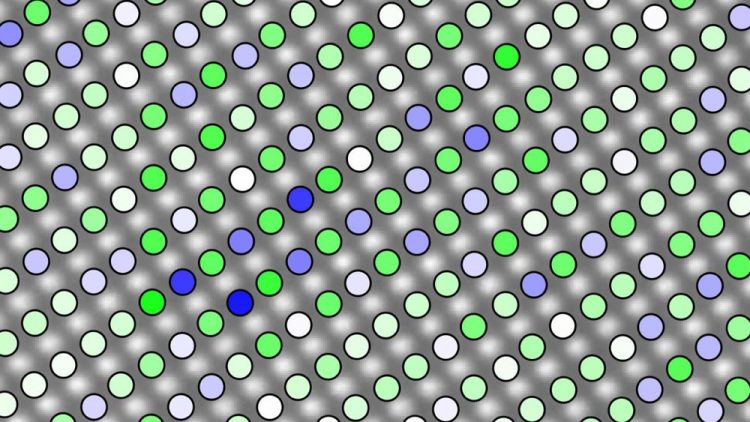Atomic structure of ultrasound material not what anyone expected

This is an atomic resolution image illustrating the chemical distribution in lead magnesium niobate. Due to mass contrast, columns of atoms rich in magnesium (blue markers) can be discriminated from columns rich in niobium (green markers). Credit: James LeBeau
“This work gives us information we can use to better understand how and why PMN behaves the way it does – and possibly other relaxor materials as well,” says James LeBeau, an associate professor of materials science and engineering at North Carolina State University and corresponding author of a paper on the work.
“What we've found is that the arrangement of atoms in PMN gradually shift along a gradient, from areas of high order to areas of low order; this happens throughout the material,” LeBeau says. “That's substantially different than what conventional wisdom predicted, which was there would be alternating areas of high order and no order, right next to each other.”
This information can be fed into computational models to provide new insights into how PMN's atomic structure influences its characteristics.
“This won't happen overnight, but we're optimistic that this may be a step toward the development of processes that create PMN materials with microstructures tailored to emphasize the most desirable characteristics for ultrasound, sonar or other applications,” LeBeau says.
“It could also potentially offer insights into the role of atomic structure in other relaxor materials, providing similar long-term benefits for the entire class of materials.”
###
The paper, “Gradient chemical order in the relaxor ferroelectric Pb(Mg1/3Nb2/3)O3,” is published in the journal Applied Physics Letters. Lead author of the paper is Matthew Cabral, a Ph.D. student at NC State. The paper was co-authored by Elizabeth Dickey, a professor of materials science and engineering at NC State; and Shujun Zhang, a professor at the University of Wollongong.
The work was done with support from the Center for Dielectrics and Piezoelectrics, a National Science Foundation-funded center based at NC State that operates under grants IIP-1361571 and IIP-1361503. Additional support came from the Data-Enabled Science and Engineering of Atomic Structure National Science Foundation Research Traineeship, under grant DGE-1633587; and the Office of Naval Research Global, under grant N62909-16-12126.
Media Contact
All latest news from the category: Materials Sciences
Materials management deals with the research, development, manufacturing and processing of raw and industrial materials. Key aspects here are biological and medical issues, which play an increasingly important role in this field.
innovations-report offers in-depth articles related to the development and application of materials and the structure and properties of new materials.
Newest articles

High-energy-density aqueous battery based on halogen multi-electron transfer
Traditional non-aqueous lithium-ion batteries have a high energy density, but their safety is compromised due to the flammable organic electrolytes they utilize. Aqueous batteries use water as the solvent for…

First-ever combined heart pump and pig kidney transplant
…gives new hope to patient with terminal illness. Surgeons at NYU Langone Health performed the first-ever combined mechanical heart pump and gene-edited pig kidney transplant surgery in a 54-year-old woman…

Biophysics: Testing how well biomarkers work
LMU researchers have developed a method to determine how reliably target proteins can be labeled using super-resolution fluorescence microscopy. Modern microscopy techniques make it possible to examine the inner workings…





















